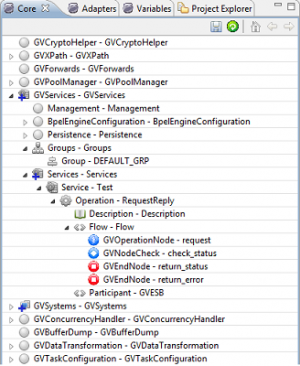Difference between revisions of "The views"
(→Vulcon view) |
|||
| (18 intermediate revisions by the same user not shown) | |||
| Line 1: | Line 1: | ||
| − | |||
[[File:viewVulcon.png|thumb|view {{VULCON}}]] | [[File:viewVulcon.png|thumb|view {{VULCON}}]] | ||
| − | *Core: Represents the | + | ==Vulcon perspective== |
| − | * | + | *Core view: provides all tools to configure {{GVESB}} services. |
| − | * | + | *Adapters view: Represents the external systems invocation entry point to {{GVESB}} services. |
| + | *Variables view: Represents the file where you define the variables identified in previous views. | ||
| + | *Project explorer: Displays, in a tree structure, all of the files and projects under your workspace directory. | ||
| + | |||
| + | ==Core view== | ||
| + | Core view is composed by many elements each one having its own role in {{GVESB}} context. | ||
| + | *[[GVCryptoHelper]] from this element it's possible manage the configuration of key store and keys used by GreenVulcanoESB cypher framework. | ||
| + | *[[GVXPath]] allows the configuration of XPATH library. | ||
| + | *[[GVForwards]]from this element it's possible manage {{GVESB}} JMS Forward configuration. | ||
| + | *[[GVPoolManager]] allows the configuration of a poll object(EJB, MDB, WS...) in {{GVESB}}. | ||
| + | *[[GVServices]] use this section to configure new service. | ||
| + | *[[GVSystems]] contains configurations of the systems interfaced to GreenVulcanoESB. | ||
| + | *[[GVPolicy]] defines the configuration of the GreenVulcano® ESB ACL Policy framework. | ||
| + | *[[GVConcurrencyHandler]] define subsystem's max concurrency on service invocation. | ||
| + | *[[GVBufferDump]] allows the [[GVBuffer]] size dump configuration. | ||
| + | *[[GVDataTransformation]] this element contains the configuration for data transformation. | ||
| + | *[[GVTaskManagerConfiguration]] defines the configuration of the GreenVulcanoESB Default Timer task manager. | ||
| + | |||
| + | ==Adapters view== | ||
| + | ==Variables view== | ||
Sight Core expanding the voice GVServices - GVServices, you may notice that the configuration of services is divided into two major components: | Sight Core expanding the voice GVServices - GVServices, you may notice that the configuration of services is divided into two major components: | ||
| − | *Groups: The element groups in turn contains n sub-elements of type group. Each group contains the configuration of the service group. A group of services allows you to manage the state of activation of multiple services simultaneously. | + | *Groups view: The element groups in turn contains n sub-elements of type group. Each group contains the configuration of the service group. A group of services allows you to manage the state of activation of multiple services simultaneously. |
| − | *Services: Contains the configuration of services. Are specified for each service enabled clients, server systems, operating procedures, notes and more. Expand the Services under GVServices - GVServices, the user sees the name of the service, the type of operation and all the nodes used to create the flow | + | *Services view: Contains the configuration of services. Are specified for each service enabled clients, server systems, operating procedures, notes and more. Expand the Services under GVServices - GVServices, the user sees the name of the service, the type of operation and all the nodes used to create the flow. |
| − | |||
| − | |||
| − | |||
| − | |||
| − | |||
| − | |||
| − | |||
| − | |||
Latest revision as of 11:49, 26 February 2013
Vulcon perspective
- Core view: provides all tools to configure GreenVulcano® ESB services.
- Adapters view: Represents the external systems invocation entry point to GreenVulcano® ESB services.
- Variables view: Represents the file where you define the variables identified in previous views.
- Project explorer: Displays, in a tree structure, all of the files and projects under your workspace directory.
Core view
Core view is composed by many elements each one having its own role in GreenVulcano® ESB context.
- GVCryptoHelper from this element it's possible manage the configuration of key store and keys used by GreenVulcanoESB cypher framework.
- GVXPath allows the configuration of XPATH library.
- GVForwardsfrom this element it's possible manage GreenVulcano® ESB JMS Forward configuration.
- GVPoolManager allows the configuration of a poll object(EJB, MDB, WS...) in GreenVulcano® ESB.
- GVServices use this section to configure new service.
- GVSystems contains configurations of the systems interfaced to GreenVulcanoESB.
- GVPolicy defines the configuration of the GreenVulcano® ESB ACL Policy framework.
- GVConcurrencyHandler define subsystem's max concurrency on service invocation.
- GVBufferDump allows the GVBuffer size dump configuration.
- GVDataTransformation this element contains the configuration for data transformation.
- GVTaskManagerConfiguration defines the configuration of the GreenVulcanoESB Default Timer task manager.
Adapters view
Variables view
Sight Core expanding the voice GVServices - GVServices, you may notice that the configuration of services is divided into two major components:
- Groups view: The element groups in turn contains n sub-elements of type group. Each group contains the configuration of the service group. A group of services allows you to manage the state of activation of multiple services simultaneously.
- Services view: Contains the configuration of services. Are specified for each service enabled clients, server systems, operating procedures, notes and more. Expand the Services under GVServices - GVServices, the user sees the name of the service, the type of operation and all the nodes used to create the flow.
